In the high-stakes world of sports, victory is measured in milliseconds, and the difference between a win and a loss can come down to a single, subtle movement. For decades, coaches and analysts have relied on video footage to dissect game performance, but this has always been a time-consuming, manual process. But nowadays, video annotation for sports analytics has helped enhance the overall performance.
Enter video annotation, a powerful technology that is transforming sports analytics from a manual chore into a data-driven science. By systematically labeling and tagging every frame of a video, teams can convert raw footage into structured, actionable data that fuels winning strategies. This isn’t just about drawing boxes around players. Video annotation is a sophisticated process that captures a wealth of information, turning every moment of a game into a valuable data point.
According to Allied Market Research, the global sports analytics market is projected to reach $22 billion by 2030, growing at a CAGR of over 21%. Much of this growth is fueled by AI-powered video analysis, which depends on precise and comprehensive annotation.
“Data doesn’t just tell the story of a game — it rewrites how the game is played.” — Sports Technology Analyst
The Anatomy of Sports Video Annotation
Video annotation for sports analytics goes far beyond simple object detection. It involves a variety of techniques to create rich, multi-layered datasets:
- Player and Ball Tracking: Using bounding boxes or polygons to track the exact position of every player and the ball, frame by frame. This data is used to analyze movement patterns, speed, and spatial relationships.
- Keypoint Annotation: By labeling specific joints (shoulders, elbows, knees, etc.), analysts can build a skeletal model of an athlete’s body. This enables detailed biomechanical analysis of form, posture, and technique, which is critical for injury prevention and performance optimization.
- Event Tagging: Human annotators tag specific in-game events—passes, shots, tackles, dribbles, fouls. This qualitative data provides context for quantitative movement data, allowing coaches to understand not only what happened but also why.
- Play and Formation Classification: Annotators can label entire sequences to identify plays, tactical formations (like a 4-4-2 in soccer or a full-court press in basketball), and defensive schemes.
- Semantic Segmentation and 3D Annotation: More advanced techniques separate playing areas into zones or use LiDAR/multi-angle inputs for 3D trajectory analysis, useful in baseball, cricket, and American football.
From Raw Data To Winning Strategies
Once annotated, sports video becomes a treasure trove of insights. Structured data can be fed into machine learning models to identify patterns invisible to the human eye, directly contributing to winning strategies:
- Tactical Analysis: By analyzing player positioning and movement patterns, teams can uncover a wealth of tactical insights. For instance, an AI model can identify a defensive weakness when a specific player moves out of position, or it can pinpoint the most effective passing channels to exploit an opponent’s defense.
- Player Performance and Development: Coaches gain microscopic views of technique. A baseball coach can analyze a pitcher’s arm angle to improve velocity and prevent injury; a tennis coach can dissect footwork to create more powerful shots.
- Injury Prevention: Keypoint annotation supports biomechanical analysis to identify risky movements. By flagging subtle changes in gait or posture, teams can intervene early to prevent injuries.
- Opponent Scouting: Annotated footage of opponents reveals player tendencies (e.g., a forward who always shoots from the left side of the box) and common set-piece strategies.
- Automated Content Creation: Annotated data powers highlight reels, real-time stats, and interactive fan experiences, proving that its value extends beyond the field of play.
Mini Case Study: A European soccer club adopted video annotation to tag every pass, shot, and defensive action. Within one season, they improved possession efficiency by 12% and reduced defensive errors by 15%, directly impacting league performance.
The Human-in-the-Loop Advantage
While AI can automate much of this process, the speed and complexity of sports present challenges—occluded players, rapid movements, or subjective fouls. That’s why a Human-in-the-Loop (HITL) process is essential. Human experts review and correct AI-generated annotations, ensuring accuracy and consistency. This collaborative approach delivers the highest-quality datasets, which, in turn, fuel the most reliable AI models.
“The challenge isn’t collecting sports data—it’s making sense of it at scale with accuracy and context.” — Head of Performance Analytics, Professional Soccer Club
Challenges in Sports Video Annotation
Video annotation has the power to transform sports analytics, but it also comes with unique obstacles that organizations must address to ensure success:
- Massive Data Volumes: High-definition footage at 60 fps produces millions of frames per match. For example, a single soccer game can generate over 1.5 million frames requiring detailed annotation. Without automation or large-scale teams, this quickly becomes overwhelming.
- Fast, Overlapping Movements: In high-intensity sports like basketball or hockey, multiple players interact in tight spaces, occluding each other and the ball. This makes it difficult for both AI and human annotators to track positions, trajectories, and actions accurately.
- Consistency and Standards: Different annotators may interpret events differently—was that contact a foul or incidental? Maintaining annotation guidelines and ensuring consistency across leagues, teams, and annotators is critical to prevent bias and misinterpretation.
- Sport-Specific Needs: Each sport requires unique annotation strategies. Baseball annotation may focus on pitch trajectory and swing mechanics, while swimming requires tracking limb movements underwater. One-size-fits-all annotation frameworks rarely work.
- Cost and Time Constraints: Manual annotation is extremely resource-intensive. Without outsourcing or semi-automation, projects can take months and consume significant budgets, delaying time-to-insight for teams relying on data.
- Privacy and Compliance: Especially in youth and amateur leagues, video annotation raises questions around athlete privacy and consent. Teams must ensure compliance with regional regulations while managing sensitive data.
“The complexity of annotating sports video lies not in the collection of footage, but in ensuring that every frame is accurate, consistent, and relevant for real-world use.” — Senior Sports Data Scientist
Industry Trends and Applications
Sports organizations worldwide are rapidly embracing annotation-driven AI, and several key trends are shaping the future of the industry:
- Adoption by Elite Leagues: The NBA, NFL, and Premier League are integrating annotation-driven AI for scouting, performance, and fan engagement. For example, the NBA has partnered with AI analytics firms to analyze rebounding patterns and shot mechanics, leading to measurable improvements in player development programs.
- Integration with Wearables: Combining annotated video with biometric data provides 360° athlete profiles, enabling coaches to correlate movement patterns with physiological markers such as heart rate and recovery metrics. This integration offers a holistic view of athlete health and performance.
- Market Growth: The global sports technology market, which includes video analytics, is expected to surpass $40 billion by 2027. Analysts attribute much of this growth to professional leagues investing heavily in AI-driven insights to gain a competitive edge.
- VAR and Officiating: Annotated video powers AI tools that assist referees in making faster, fairer decisions. FIFA’s Video Assistant Referee (VAR) system, for instance, relies on annotated data to review goals, penalties, and offside calls with greater accuracy.
- Enhanced Fan Engagement: Broadcasters and streaming services use annotation-driven analytics to overlay stats in real time, generate automated highlight reels, and personalize viewing experiences for fans worldwide.
The Role of BPO in Sports Video Annotation
For most organizations, in-house annotation at this scale is impractical. Professional sports clubs, leagues, and broadcasters generate thousands of hours of high-definition footage every season, and attempting to manage annotation internally can drain resources and slow down time-to-insight. BPO providers deliver critical advantages:
- Scalability: Distributed teams can handle huge volumes of annotation quickly, ensuring that entire seasons of footage are processed without delay. For example, annotating every play in an NBA season requires millions of data points, which few internal teams can manage.
- Expertise: Annotators trained in the rules and dynamics of specific sports provide more accurate labeling of events, ensuring that passes, fouls, offsides, and set plays are annotated correctly.
- Quality Assurance: Multi-layer QA frameworks, including consensus checks and gold-standard datasets, reduce annotation errors and improve reliability across thousands of hours of footage.
- Compliance and Security: BPO partners operate under strict data security protocols, ensuring compliance with privacy regulations when working with sensitive athlete or team data.
- Cost Efficiency: Outsourcing significantly reduces overhead costs while accelerating time-to-insights. This allows organizations to reinvest resources into coaching, scouting, and athlete development.
Deloitte reports that outsourcing annotation reduces project timelines by up to 35%, giving sports organizations faster access to actionable insights. Real-world examples show that leagues partnering with annotation BPOs have been able to roll out new analytics dashboards mid-season. This helps improve coaching decisions and enrich broadcast experiences.
Annotera’s Expertise
At Annotera, we specialize in video annotation for sports analytics. Our solutions include:
- Comprehensive Annotation Services: From bounding boxes to play classification, tailored to different sports.
- Bias-Aware Workflows: Ensuring fair and inclusive datasets across diverse player groups.
- Human-in-the-Loop QA: Rigorous checks to guarantee accuracy.
- Scalable Teams: Global annotation teams to meet seasonal spikes in sports data.
Case Example: Annotera supported a U.S.-based analytics company by annotating thousands of hours of basketball footage. Further, shot accuracy detection improved by 19%, giving their clients a competitive edge in scouting and preparation.
Executive Takeaway
In a competitive landscape where every detail matters, video annotation is no longer a luxury—it’s a necessity. It is the bridge between raw, unstructured video and the data-driven decisions that define champions. By treating every frame as a data point, video annotation gives analysts the edge to turn potential into victory.
“The winners of tomorrow will be the teams that can translate data into decisions today.” — Sports Performance Consultant
Contact Annotera for Sports Annotation Services
Video annotation is revolutionizing how sports are played, coached, and experienced. Further, by turning raw video into structured insights, teams and organizations can move from frame-by-frame analysis to winning strategies.
Ready to take your sports analytics to the next level? Partner with Annotera today and unlock the power of video annotation for performance, strategy, and fan engagement.


